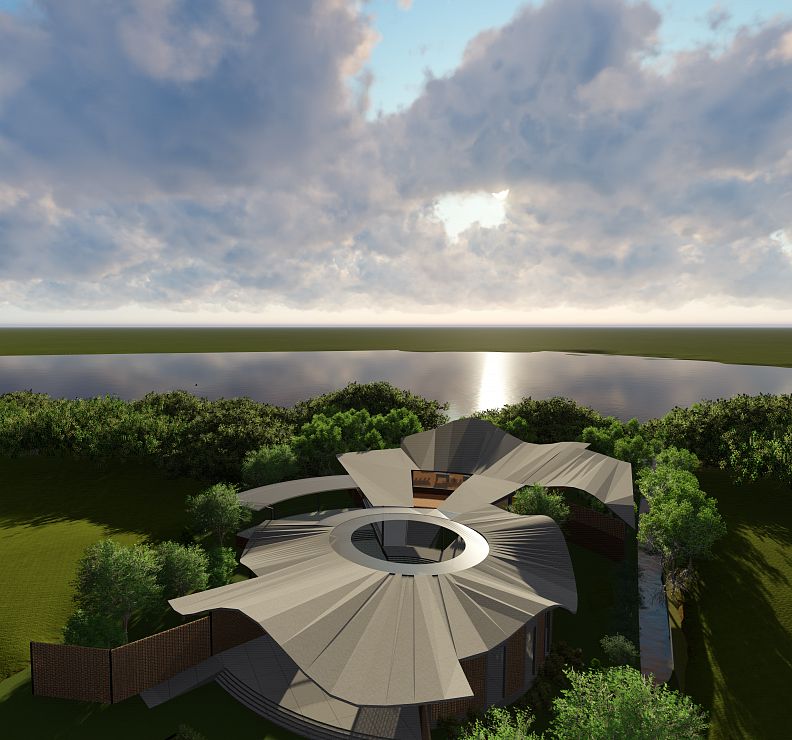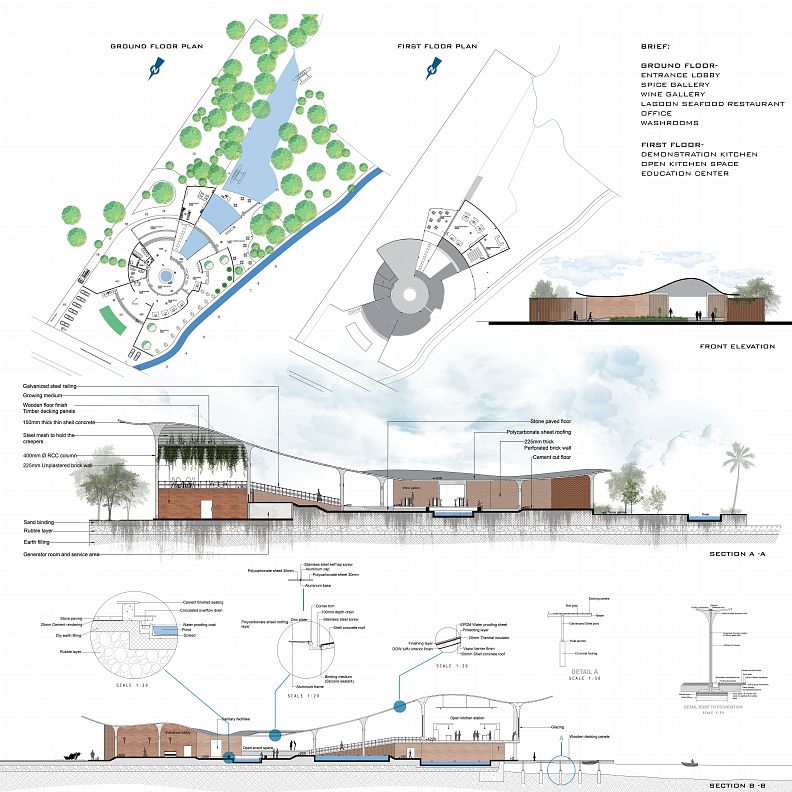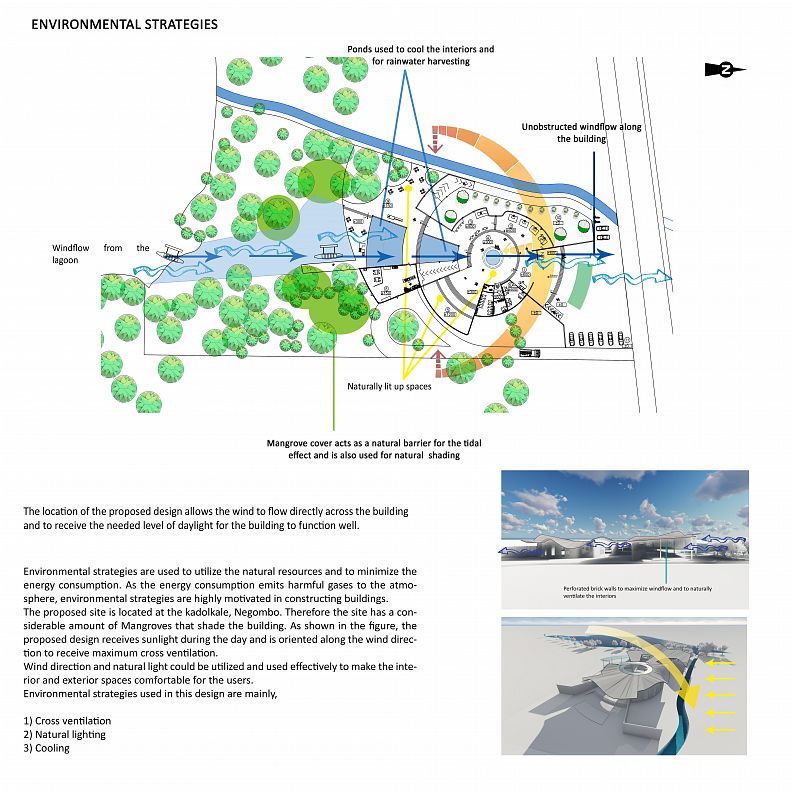Culinary Heritage Center - Negombo, Sri Lanka

Project idea
Project - To design a Heritage/Cultural Center in Negombo which could add value to the proposed aero-city development and to address the problem of lacking an activity hub that articulate its' cultural heritage.
Objectives -
1. To create an activity hub which articulated the cultural heritage of Negombo.
2. To celebrate the cultural diversity which bring together diverse groups of people.
3. To enhance the local livelihoods and traditionalpractices.
The iconic city of Negombo, which lies upon the shores of the western coast of Sri Lanka, is one that boasts of a rich culture. Different ethnic groups have harmoniously weaved their own unique customs and traditions to the tapestry of life in Negombo. People of different ethnicities live like one family, which has a history that truly fascinates. This famous fishing city has passed different eras and has adapted to the changes which were introduced to them. Embracing Catholicism is one of the major adaptations which took place in history and it has given a unique identity to Negombo until the present day. Even today, after many centuries, Negombo is known as ‘Little Rome’. It has always been a welcoming city for everyone. The merry attitude of the catholic community has further increased the tranquility of the different ethnic groups. Sri Lanka as a whole is a multicultural country, but Negombo has the unique cultural values to adapt and evolve with new changes, and the catholic community influence the surrounding with their values of “togetherness” which is indeed vital in keeping the unity among the diverse ethnic groups. For a multicultural city to maintain the unity while celebrating the diversity, needs to have community spaces for the locals as well as for the tourists to be connected with the culture of the specific place. Lack of these community spaces can make it harder for newcomers to become connected into the community. But often, the lack of these spaces isn’t just something that affects newcomers, it’s something that reflects the fact that people in the community are not connected to each other.
Problem Identified - Issues related to the present community in Negombo was identified through a background study. The multicultural community of Negombo lives a scattered lifestyle and does not share strong connections with other ethnic groups and does not have appropriate spaces to build up the sense of community and belongingness.
Value of community gathering spaces -
Community gathering places are where people from a neighborhood come together to socialize and connect. There are many different types of spaces that could function as gathering spots in a neighborhood: coffee or tea shops, restaurants, bars, parks, town squares, and other outdoor spaces, churches, public-access buildings or outdoor terraces on a university campus, public government buildings like libraries, corporate office buildings with public areas, the possibilities are endless. These community gathering places can build up strong connections among the community which brings them pride of their own culture. This is needed in order to preserve the cultural heritage of a place. Therefore community gathering spaces are essential for a local culture to share the values and build respect on each other’s values and cultures. Lack of community can lead to various negative impacts which can create conflicts and misunderstandings among groups of people who does not understand the values of a multicultural community. In order to celebrate the unity of different ethnic groups in Negombo, the community needs to have a pride of their cultural identity. The sense of belongingness can create this impact with active and interesting community gathering spaces which preserves and promote the culture of Negombo.
Theme of the project -
Culinary heritage can be used as the unifying factor in this project. Food culture has always unified people and the community. It is also of heritage value that could bring identity to the culture of Negombo and the community. This can be stated as the best solution for the proposed project in order to bring together the community and to create sense of belongingness and unity. How to bring the different social groups together is the key aspect in this design project. Therefore in order to gather people in this heritage center, it is proposed to provide open kitchen spaces which demonstrate the local culinary practices that can be observed by the people. These open kitchens are used by a selected group of lower income families who are willing to use these kitchen spaces which are provided for free. The food prepared in these kitchens are sold at the restaurant space which can give them an additional income. The preparation of different types of food is an exciting sight to see and to learn. Therefore these types of new activities to the community could encourage people to gather and share the differences. These live kitchens are promoted through television shows which would be recorded live at these demonstration kitchen spaces. This experience can be witnessed daily at the kitchen studio which encourage the local community more and it also gives them cultural identity for being recognized as unique Negombo culinary heritage. Culinary heritage focuses on experience of locally sourced food other than just sightseeing places. “Any tourism experience in which one learns about, appreciates, and/or consumes food and drink that reflects the local, regional or national cuisine, heritage, culture, tradition or culinary techniques – OCTA (Ontario Culinary Tourism Alliance)”. The potential of Negombo for this type of tourism is enormous as it has all the resources it needs to build this tourism industry. The variety of fishing, local cuisine, a long history of spice trade and the household winery production are the main resources that Negombo has which could contribute to this venture in creating unique Negombo cuisine that shows the history and the essence of the culture in Negombo. Therefore the theme for the proposed project could be derived as a “Culinary heritage center”. This is a place where the tourists and the locals can come together and share the unique local food experience of Negombo. This initiative encourage the locals to maintain their unity and to feel proud of their culture while promoting it to the tourists. The taste of Negombo culture can be portrayed through this exciting activities and it can become an iconic place to host food festivals which could add more life and colour to this vibrant city.
Project description
Ambition -
Negombo needs a place for the community to come together and strengthen their connections while celebrating the diversity of the community.
Concept- "An Expression of Unified Diversity."
The proposed project aims at creating a space for the community of Negombo which invoke their communal feeling and togetherness and to celebrate the cultural diversity, Therefore the conceptualization of spaces to achieve this ambition needs to be integrated with the diverse groups of people and activities which promote unity among them.
Therefore the concept looks at expressing the unity in diversity. The spaces of the design needs to be connected and these connection needs to express the diverse but unified quality making it a coherent whole. Most of the spaces need to have the informal quality where it encourage free movement and human interaction.
Architectural Brief -
Indoor spaces
1. Entrance lobby (Welcoming entrance yet less interactive spaces) - 80sqm
2. Spice gallery (Gives the sense of the historic spice trade in Negombo. Opened out to the central open space and the spice garden.) - 100sqm
3. Wine gallery (Opens up to the central open space and the spice garden allowing to enjoy the unique essence of the household winery in Negombo.) - 80sqm
4. Lagoon seafood restaurant (Allows to experience the location of the site and to feel the lagoon and mangrove environment.) - 120sqm
5. Demonstration kitchen (Meeting point of diverse groups. Allows to comfortable interact and create connections.) - 100sqm
6. Open kitchen spaces (The communal feeling can be celebrated and enjoyed in this space with the unified diversity of culinary practices and the groups of people.) - 200sqm
7. Education center (The preservation of culinary heritage is promoted using this function. Same spaces used for open kitchens is utilized for this space.)
8.Office space (Used for the management of the center.)
9. Sanitary facilities
Male -( 06 urinals/02 WCs/02 wash basins )
Female - (08 WCs/04 wash basins)
Disabled washroom
Outdoor spaces
10. Central open area for gathering (Space can be utilized to host cultural events and food festivals. This encourage people to interact and create connections.
11. Car park - 08 vehicles
12. Service entrance and service areas
The spatial progression of this design is designed according to the level of human activity and interaction created in the spaces. From the entrance to the main activity space the levels of the design is raised to show the increase of human connections. The main functioning space is located in the first floor and is ramped up to allow anyone to access this space. The unified diversity and the connection of people is encouraged through open and transparent spaces which does not interrupt free movement.
Technical information
Substructure - With the findings of the site analysis, shallow foundations were considered as best suited for the design. Therefore isolated footings are used as the design has used individual mushroom columns as a key feature.
Superstructure -
Flooring - The main flooring proposed is cement rendering with cut and polished cement finish as it is a public building. Also outdoor areas have used stone paving and the restaurant areas have used timber decking panels.
Walls - The walls are non load bearing as the main structure is a shell concrete roof supported on a concrete column system. Therefore the main wall material was proposed as brick and most of the spaces have used perforated brick walls to encourage natural lighting and ventilation. It also increase the lightness of the design.
Roof - A shell concrete roof structure is proposed for the design to achieve the shape of the roof and to give a floating feeling to the design. It enhance the lightness of the building and helps to achieve the goal of creating comfortable spaces to interact.
The mushroom column system is used as an architectural feature as well as to drain the water collected on the roof using an inbuilt down pipe system.






